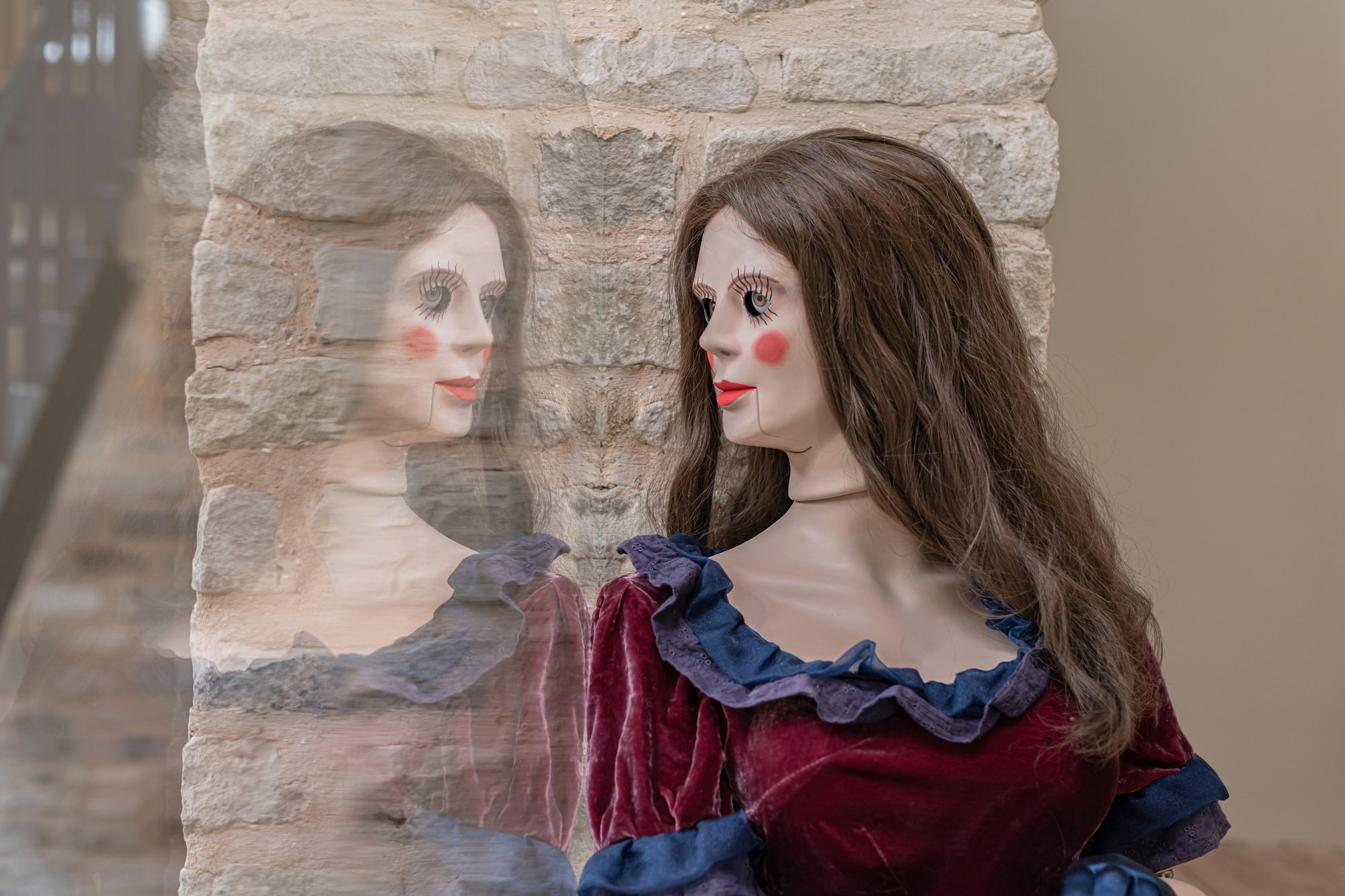Blurring the boundaries between life and death, memory and fantasy, Weber’s work conjures a world rich in theatricality and mysticism, where women inhabit dreamlike spaces of longing, resistance, and transformation.
Whispering Silence marks Marnie Weber’s return to the UK with her first solo exhibition since 2009. Bringing together film, painting, collage, and sculpture, the show surveys two decades of the artist’s practice. At its centre are two key films—House of the Whispering Rose (2025) and The Sea of Silence (2009)—through which Weber continues her exploration of feminine identity, mortality, and the supernatural. Blurring the boundaries between life and death, memory and fantasy, her work conjures a world rich in theatricality and mysticism, where women inhabit dreamlike spaces of longing, resistance, and transformation.
House of the Whispering Rose (2025) explores themes of fading relevance, solitude, and decline through the poignant narrative of Rose Bloom, an ageing silent film starlet living alone in an abandoned mansion. Haunted by visions of her youthful self, she clings to the remnants of a lost career, her isolation giving rise to hallucinatory companions. These surreal episodes flicker between memory and fantasy, grief and awakening, reflecting on deterioration and the possibility of renewal. A flashback scene captures Rose’s thwarted transition from stage to screen, deepening her sense of loss. As spring approaches and time moves forward, the film paints a complex portrait of a woman caught between the past and the uncertain future, navigating her own evolution and rebirth.
The series of oil paintings on paper, conceived as Rose’s own, fuse film and fantasy. Set against the rolling backdrop of the South Downs and the grounds of Inspection Pit, the paintings tether Rose—and the work itself—to nature, place, and the enduring legacy of surrealism that permeates the Sussex landscape. The work speaks to the psychology of an ageing artist, for whom painting becomes an act of conjuring and quiet resistance. Moth Girl with Sheep (2025) presents a young woman, moth-winged and barefoot, standing beside a ewe and her lambs. Her gaze dissolves the margins between human, animal, and spirit, as though she belongs to the land itself. The moth, a recurring motif in Weber’s practice, symbolises both death and metamorphosis: a fragile yet persistent creature drawn to light, a delicate emblem of hope emerging from darkness. The scene feels oddly familiar, evoking a time we can never quite place—a lingering sense of presence, where the real and imagined momentarily converge.
The Sea of Silence (2009) introduces the Spirit Girls, spectral figures suspended between life and death who seek to reclaim their voice. In the film, they encounter the Truth Speakers—a group of ventriloquist dolls through whom they hope to communicate with the living. Once granted speech, the girls deliver a performance that oscillates between philosophical reflections on truth, beauty, and silence, and crude, absurdist humour. This uneasy interplay between voice and body, presence and absence, draws on the ancient roots of ventriloquism—once viewed not only as entertainment but as a mystical act of summoning voices from within or beyond.
The Spirit Girls are part of a broader conceptual, multidisciplinary project by the artist that explores feminine identity, memory, and the supernatural. Portrayed as an all-female band who died tragically in the 1970s, they return in ghostly form, unseen and unheard by the living—except for the animals who remain attuned to their presence. Through sculpture, film, collage, and performance, Weber constructs a world where these apparitions function as conduits of lost narratives, channeling both personal and collective memory. In The Sea of Silence (2009), their voices rise only to reveal that silence, in the end, may be their most powerful form of expression.
Sculptures and collages of the Spirit Girls, the Truth Speakers, and their animal companions create a richly textured landscape that anchors the relationships between Weber’s characters. These works are not merely representations—they are relics, charged with the emotional intensity of the Spirit Girls’ ethereal world. In Sunset Surrender (2009), an eerie tableau unfolds between a life-sized ventriloquist doll—her painted face frozen in stillness—and an oversized anthropomorphic rabbit. Dressed in a velvet gown, the doll seems poised on the edge of submission, while the rabbit—its gesture at once gentle and imposing—appears to either shield or dominate her. This uncanny interaction provokes a psychological tension, touching on themes of power, vulnerability, and the fine line between protection and control — all of which are central to Weber’s practice.
Marnie Weber lives and works in Los Angeles, CA, and Milford, CT. She exhibits internationally, most recently presenting her solo show When Roses Bloom at Heidi Gallery, Berlin. Her work is held in prestigious public collections, and for Whispering Silence, loans have been made from the collections of MAMCO (Musée d'Art Moderne et Contemporain), Geneva, and Le Musée des Beaux-Arts de La Chaux-de-Fonds, Switzerland. In addition to her work as an artist, Weber leads a significant musical career. She first emerged as part of the early Los Angeles punk scene, performing as a musician, before transitioning into performance art and filmmaking, and has since released numerous solo albums.
-
Born 1989 in Melbourne, Australia
Lives and works in London, UK
2023-Present
Associate Director, Inspection Pit, West Sussex, UK
2008-2010
BA Art History, University of Melbourne, Australia -
Marnie Weber: Whispering Silence, curated by Phoebe Ahern, Inspection Pit, West Sussex, UK, 2025.
Photo: Studio Adamson




















